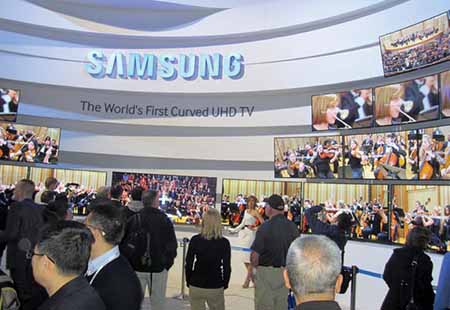The More Things Change


Aereo CEO Chet KanojiaWASHINGTON—Befitting its near mid-decade position, 2014 kept the broadcast industry smack-in-the-middle of an array of business and technology issues, most of them with no evident ending point. Even the Aereo case—seemingly concluded when the Supreme Court deemed the service illegal in June and the company filed for bankruptcy in November—threatens a phoenix-like revival thanks to the FCC’s emerging “over-the-top” rulemaking procedure.
From spectrum auctions to ultra-high definition displays to the ongoing saga of ATSC 3.0, the past year and the new one ahead are loaded with never-ending processes. Despite plenty of “benchmark” moments, from the Sochi Winter Olympics to a Los Angeles channel-sharing experiment, 2014 offered a tapestry of events and technology developments, most of which are likely to remain works in progress for years to come. The past year offered glimpses of technologies—from news drones to IP networks—that are in early and intermediate stages despite years of evolution that have brought them this far.
THE ‘COMPLEX MATRIX’ THAT IS UHD
Ultra high definition television is a good example, adding an economic component to the complex matrix of technology and policy factors. UHDTV is expected to be a highlight at this week’s International Consumer Electronics Show, with more companies introducing larger displays and lower prices for the 4K version. LG, Sharp, Samsung and others will offer glimpses of 8K technology, still not likely to reach consumers until decade’s end.
As evidence that UHDTV is indeed finding a market: Sales of UHD displays accounted for about 10 percent of overall TV sales revenue in 2014. Analysts expect that proportion to grow.
The big question is how broadcasting figures into the 4K landscape. It’s also a reminder of the interconnection of so many ongoing developments, since UHD factors into the Advanced Television Systems Committee evaluation of its 3.0 standard.
With Netflix and other streaming video services plus satellite TV providers adding 4K programming, the appeal of UHDTV is becoming evident. At the 2014 NAB Show, Ateme, Ericsson, Elemental Technologies and others touted their H.265.HEVC encoding solutions, which could accelerate the inventory of 4K content, a critical factor in the adoption curve. Canon, JVC, Panasonic and Sony, among others, are shipping 4K production monitors, further reinforcing the reality that 4K is coming. Theaters are promoting 4K movies that they exhibit in much the same way they hyped 3D movies several years earlier.
Broadcasters are pondering how to cash in on 4K, given spectrum constraints. Many questions were raised about this capability during 2014, but answers are still sparse.

Curved UHDTV sets created a big buzz at the 2014 International CES.SPECTRUM AUCTIONS ON THE HORIZON
By the time the FCC issued its proposed rules for the broadcast spectrum incentive auction, it was already clear that any such auctions won’t occur until at least 2016, receding again from earlier expectations. When the FCC adopted its Auction Report and Order in May 2014, there were still dreams of a “rocket-docket,” but now the deadlines augur a long deliberation. The FCC’s official notification about the auction procedure—including methodologies for establishing pricing processes and spectrum repacking procedures—came out in early December (see “FCC Aims to Clear 84 MHz of Spectrum,”). The slow process during 2014—with the next rounds of comments and replies due at the end of January and February respectively—underscore that policy makers will remain in the middle of a muddle about auction policies well into 2015.
And that doesn’t account for the pushback from NAB and others. The commission’s politically split decision in the December rulemaking (three Democrats supporting the auction process plan, two Republicans opposing it) is a harbinger of larger policy feuds ahead… and delays.
AND THEN THERE WAS AEREO
Media mongers were transfixed by the legal maneuverings and sheer bravura of the Aereo saga, which wended through courts, board rooms and the FCC throughout 2014. When the Supreme Court deemed Aereo’s service illegal on June 25, resolving inconsistent decisions by lower courts about the legality of Aereo’s retransmission of broadcast signals, most observers expected the company to disappear. Even the major financial backer, Barry Diller and his InterActiveCorp which had committed $25 million to the venture, conceded defeat.

At the 2014 NAB Show, Elemental Technologies was among a number of companies demonstrating their H.265 HEVC encoding solutions. The Supreme Court’s 6-3 decision ruled that Aereo’s streaming technology did “not distinguish [it] from cable systems” and hence Aereo was not entitled to transmit copyrighted broadcast programs via its personalized antenna and Internet delivery system. The networks and studios gloried in the victory.
But CEO Chet Kanojia hardened his heart. Although the company “paused” its services (believed to reach fewer than 100,000 customers in the three initial New York, Boston and Atlanta markets), on June 28, Kanojia insisted that he would find a way to revive Aereo. By autumn, Aereo had laid off most of its staff, and in November, the company filed for Chapter 11 bankruptcy reorganization.
Yet, at about the same time, the FCC began floating its proposed rulemaking for “Online Video Programming Distribution” (also known as over-the-top) Internet-based video. Some observers considered the plan as a way to enable companies like Aereo to deliver channels under rules similar to those governing cable and satellite companies (also known as “multichannel video program distributors,” or MVPD). This is a regulatory process that is at the beginning—not the middle—and is likely to take years to resolve, with the potential of reshaping the video delivery business.
NET NEUTRALITY: JUST THE BEGINNING
Ditto for net neutrality. Although the term has been around for more than a decade (coined in 2003 by Columbia University Professor Tim Wu), the battle over an “open Internet” escalated in 2014 as the FCC dithered with a plan to create “fast lanes” via paid prioritization. That could allow big content aggregators such as Netflix or YouTube to dominate the broadband video ecosystem. The outpouring of outrage (especially a viral campaign that triggered nearly four million “public” comments to the FCC), brought net neutrality into the spotlight. President Obama added more pressure in November when he urged the FCC to classify Internet content under Title II rules, a move that terrifies cable and telco companies.
An FCC decision in mid-December not to seek more public input suggests that the commission may be ready for its next move by March. FCC Chairman Tom Wheeler wants to proceed quickly, although it is still unclear how he’ll resolve the battle over whether Internet services should fall under Title II (strict common carrier regulation) or Section 706 (less severe advanced telecom guidance).
Whatever the FCC decides, the net neutrality fight will inevitably wind up back in court.
And that would keep TV and telecom “in the middle” again for another year.
Get the TV Tech Newsletter
The professional video industry's #1 source for news, trends and product and tech information. Sign up below.
Gary Arlen, a contributor to Broadcasting & Cable, NextTV and TV Tech, is known for his visionary insights into the convergence of media + telecom + content + technology. His perspectives on public/tech policy, marketing and audience measurement have added to the value of his research and analyses of emerging interactive and broadband services. Gary was founder/editor/publisher of Interactivity Report, TeleServices Report and other influential newsletters; he was the long-time “curmudgeon” columnist for Multichannel News as well as a regular contributor to AdMap, Washington Technology and Telecommunications Reports; Gary writes regularly about trends and media/marketing for the Consumer Technology Association's i3 magazine plus several blogs.

